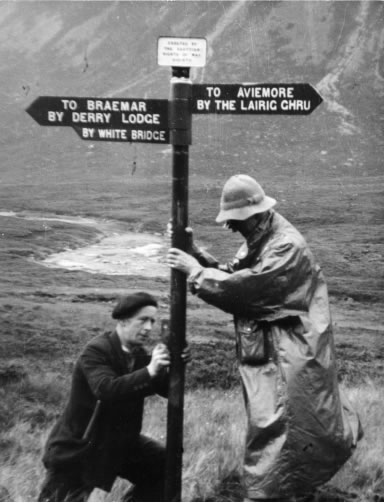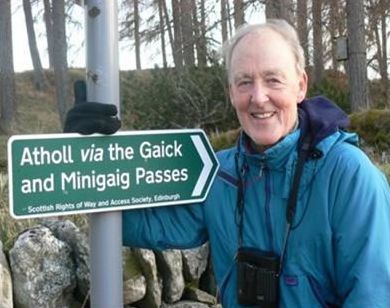THE SCOTTISH RIGHTS OF WAY & ACCESS SOCIETY (ScotWays)
George MacQuarrie
A public right of way has to go from one public place to another. Thus, they
tend to go along the glen and not up the mountain, as mountain tops are not
normally classed as public places. However, the 'walk in' is a key part of the
hill walking experience in Scotland, so rights of way matter to those who love
the hills and mountains. The Land Reform (Scotland) Act 2003 giving access to
the hills is largely a matter of right but it was not always so (the 'right
to roam' was an urban myth, or should that be rural a one?).
 The
Scottish Rights of Way and Access Society (ScotWays) dates back to 1845, rapidly
moving from its Edinburgh origins to become national in outlook as it took on
access disputes in Glen Tilt and Jocks Road (Glen Callater/ Glen Doll). These
disputes went to court and all the way to the House of Lords. The Society won
but effectively bankrupted itself in the process. Nevertheless, rights of way
were now a reality. Properly maintaining public rights of access was clearly
beyond the means of the Society and it campaigned for local authorities to take
on this responsibility. Success came with the Local Government Act in 1894.
Unfortunately, lack of resources and not much inclination meant that local authorities
rarely discharged their responsibilities over the decades thereafter in the
face of inter-war afforestation, road building and hydro schemes. The need for
local organisations to fight to retain access has remained with us.
The
Scottish Rights of Way and Access Society (ScotWays) dates back to 1845, rapidly
moving from its Edinburgh origins to become national in outlook as it took on
access disputes in Glen Tilt and Jocks Road (Glen Callater/ Glen Doll). These
disputes went to court and all the way to the House of Lords. The Society won
but effectively bankrupted itself in the process. Nevertheless, rights of way
were now a reality. Properly maintaining public rights of access was clearly
beyond the means of the Society and it campaigned for local authorities to take
on this responsibility. Success came with the Local Government Act in 1894.
Unfortunately, lack of resources and not much inclination meant that local authorities
rarely discharged their responsibilities over the decades thereafter in the
face of inter-war afforestation, road building and hydro schemes. The need for
local organisations to fight to retain access has remained with us.
A continuing need.......
The Land Reform (Scotland) Act 2003 is a wonderfully progressive piece of legislation.
However, most of the problems relating to access have remained (the current
difficulties in Glen Lyon being a topical reminder) and, of course, these are
often compounded by wind farm developments. From ScotWays point of view, the
Act does not cover all rights of way as land exempted from the Act may still
have a right of way across it. Thus, the need for vigilance and action continues,
effectively unabated.
What we do
ScotWays is a national voluntary organisation with a membership of nearly 2000,
made up of both individual and corporate members (which include access authorities,
community councils, and clubs). Although our members tend to be walkers primarily,
we cover the full range of recreation users. We have a small staff and volunteers
are vital to our work. Volunteers are actively involved in management, helping
in the office, and carrying out field work - including path monitoring, path
surveys, and path maintenance often in cooperation with access authority staff.
 ScotWays
is best known by the public for our green and white signposts. These are on
major routes throughout the country, normally indicators from public roads rather
than in the wilds. We also contribute to the cost of repair of bridges where
appropriate. ScotWays set up and maintains the National Catalogue of Rights
of Way (in cooperation with SNH). Our most recent project has seen Heritage
Paths develop, through research and promoting enjoyment of historic paths. ScotWays
also encourage enjoyment of the outdoors through publication of leaflets and
our guide book Scottish Hill Tracks.
ScotWays
is best known by the public for our green and white signposts. These are on
major routes throughout the country, normally indicators from public roads rather
than in the wilds. We also contribute to the cost of repair of bridges where
appropriate. ScotWays set up and maintains the National Catalogue of Rights
of Way (in cooperation with SNH). Our most recent project has seen Heritage
Paths develop, through research and promoting enjoyment of historic paths. ScotWays
also encourage enjoyment of the outdoors through publication of leaflets and
our guide book Scottish Hill Tracks.
ScotWays work originally concentrated on rights of way issues, but it has now
extended to cover general access to the outdoors as many issues now impinge
on the enjoyment of rights of way. We are unusual amongst organisations representing
access users, in that we deal with issues about access in and around urban areas
as well as countryside access.
www.scotways.com |
www.heritagepaths.co.uk
NEMT Front Page
| Previous Page | Volume Index
Page | Next Page | Journal Index Page
Please let the webmaster know if there
are problems with viewing these pages or with the links they contain.
 The
Scottish Rights of Way and Access Society (ScotWays) dates back to 1845, rapidly
moving from its Edinburgh origins to become national in outlook as it took on
access disputes in Glen Tilt and Jocks Road (Glen Callater/ Glen Doll). These
disputes went to court and all the way to the House of Lords. The Society won
but effectively bankrupted itself in the process. Nevertheless, rights of way
were now a reality. Properly maintaining public rights of access was clearly
beyond the means of the Society and it campaigned for local authorities to take
on this responsibility. Success came with the Local Government Act in 1894.
Unfortunately, lack of resources and not much inclination meant that local authorities
rarely discharged their responsibilities over the decades thereafter in the
face of inter-war afforestation, road building and hydro schemes. The need for
local organisations to fight to retain access has remained with us.
The
Scottish Rights of Way and Access Society (ScotWays) dates back to 1845, rapidly
moving from its Edinburgh origins to become national in outlook as it took on
access disputes in Glen Tilt and Jocks Road (Glen Callater/ Glen Doll). These
disputes went to court and all the way to the House of Lords. The Society won
but effectively bankrupted itself in the process. Nevertheless, rights of way
were now a reality. Properly maintaining public rights of access was clearly
beyond the means of the Society and it campaigned for local authorities to take
on this responsibility. Success came with the Local Government Act in 1894.
Unfortunately, lack of resources and not much inclination meant that local authorities
rarely discharged their responsibilities over the decades thereafter in the
face of inter-war afforestation, road building and hydro schemes. The need for
local organisations to fight to retain access has remained with us.  ScotWays
is best known by the public for our green and white signposts. These are on
major routes throughout the country, normally indicators from public roads rather
than in the wilds. We also contribute to the cost of repair of bridges where
appropriate. ScotWays set up and maintains the National Catalogue of Rights
of Way (in cooperation with SNH). Our most recent project has seen Heritage
Paths develop, through research and promoting enjoyment of historic paths. ScotWays
also encourage enjoyment of the outdoors through publication of leaflets and
our guide book Scottish Hill Tracks.
ScotWays
is best known by the public for our green and white signposts. These are on
major routes throughout the country, normally indicators from public roads rather
than in the wilds. We also contribute to the cost of repair of bridges where
appropriate. ScotWays set up and maintains the National Catalogue of Rights
of Way (in cooperation with SNH). Our most recent project has seen Heritage
Paths develop, through research and promoting enjoyment of historic paths. ScotWays
also encourage enjoyment of the outdoors through publication of leaflets and
our guide book Scottish Hill Tracks.